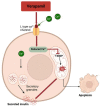Emerging Anti-Diabetic Drugs for Beta-Cell Protection in Type 1 Diabetes
- PMID: 37296593
- PMCID: PMC10253164
- DOI: 10.3390/cells12111472
Emerging Anti-Diabetic Drugs for Beta-Cell Protection in Type 1 Diabetes
Abstract
Type 1 diabetes (T1D) is a chronic autoimmune disorder that damages beta cells in the pancreatic islets of Langerhans and results in hyperglycemia due to the loss of insulin. Exogenous insulin therapy can save lives but does not halt disease progression. Thus, an effective therapy may require beta-cell restoration and suppression of the autoimmune response. However, currently, there are no treatment options available that can halt T1D. Within the National Clinical Trial (NCT) database, a vast majority of over 3000 trials to treat T1D are devoted to insulin therapy. This review focuses on non-insulin pharmacological therapies. Many investigational new drugs fall under the category of immunomodulators, such as the recently FDA-approved CD-3 monoclonal antibody teplizumab. Four intriguing candidate drugs fall outside the category of immunomodulators, which are the focus of this review. Specifically, we discuss several non-immunomodulators that may have more direct action on beta cells, such as verapamil (a voltage-dependent calcium channel blocker), gamma aminobutyric acid (GABA, a major neurotransmitter with effects on beta cells), tauroursodeoxycholic acid (TUDCA, an endoplasmic reticulum chaperone), and volagidemab (a glucagon receptor antagonist). These emerging anti-diabetic drugs are expected to provide promising results in both beta-cell restoration and in suppressing cytokine-derived inflammation.
Keywords: beta cells; hyperglycemia; investigational new drugs; type 1 diabetes.
Conflict of interest statement
The authors declare no conflict of interest.
Figures




Similar articles
-
Identifying Promising Immunomodulators for Type 1 Diabetes (T1D) and Islet Transplantation.J Diabetes Res. 2024 Dec 20;2024:5151171. doi: 10.1155/jdr/5151171. eCollection 2024. J Diabetes Res. 2024. PMID: 39735417 Free PMC article. Review.
-
Early Treatment with Empagliflozin and GABA Improves β-Cell Mass and Glucose Tolerance in Streptozotocin-Treated Mice.J Diabetes Res. 2019 Jul 30;2019:2813489. doi: 10.1155/2019/2813489. eCollection 2019. J Diabetes Res. 2019. PMID: 31467926 Free PMC article.
-
Immune therapy and β-cell death in type 1 diabetes.Diabetes. 2013 May;62(5):1676-80. doi: 10.2337/db12-1207. Epub 2013 Feb 19. Diabetes. 2013. PMID: 23423576 Free PMC article. Clinical Trial.
-
Pancreatic Alpha-Cells Contribute Together With Beta-Cells to CXCL10 Expression in Type 1 Diabetes.Front Endocrinol (Lausanne). 2020 Sep 15;11:630. doi: 10.3389/fendo.2020.00630. eCollection 2020. Front Endocrinol (Lausanne). 2020. PMID: 33042009 Free PMC article.
-
Targeting dysfunctional beta-cell signaling for the potential treatment of type 1 diabetes mellitus.Exp Biol Med (Maywood). 2018 Mar;243(6):586-591. doi: 10.1177/1535370218761662. Epub 2018 Mar 4. Exp Biol Med (Maywood). 2018. PMID: 29504478 Free PMC article. Review.
Cited by
-
Transmission of unfolded protein response-a regulator of disease progression, severity, and spread in virus infections.mBio. 2025 Feb 5;16(2):e0352224. doi: 10.1128/mbio.03522-24. Epub 2025 Jan 8. mBio. 2025. PMID: 39772778 Free PMC article. Review.
-
Dysfunctional β-cell autophagy induces β-cell stress and enhances islet immunogenicity.Front Immunol. 2025 Jan 29;16:1504583. doi: 10.3389/fimmu.2025.1504583. eCollection 2025. Front Immunol. 2025. PMID: 39944686 Free PMC article.
-
Tauroursodeoxycholic acid: a bile acid that may be used for the prevention and treatment of Alzheimer's disease.Front Neurosci. 2024 Feb 19;18:1348844. doi: 10.3389/fnins.2024.1348844. eCollection 2024. Front Neurosci. 2024. PMID: 38440398 Free PMC article. Review.
-
Target Discovery to Diabetes Therapy-TXNIP From Bench to Bedside With NIDDK.Endocrinology. 2025 Mar 24;166(5):bqaf055. doi: 10.1210/endocr/bqaf055. Endocrinology. 2025. PMID: 40105688 Review.
-
A novel class of oral, non-immunosuppressive, beta cell-targeting, TXNIP-inhibiting T1D drugs is emerging.Front Endocrinol (Lausanne). 2024 Oct 4;15:1476444. doi: 10.3389/fendo.2024.1476444. eCollection 2024. Front Endocrinol (Lausanne). 2024. PMID: 39429740 Free PMC article. Review.
References
-
- Draznin B., Aroda V.R., Bakris G., Benson G., Brown F.M., Freeman R., Green J., Huang E., Isaacs D., Kahan S., et al. Classification and Diagnosis of Diabetes: Standards of Medical Care in Diabetes—2022. Diabetes Care. 2022;45:S17–S38. - PubMed
-
- Australia D. Managing Type 1 Diabetes. 2021. [(accessed on 19 May 2023)]. Available online: https://www.diabetesaustralia.com.au/managing-diabetes/type-1/
-
- Orban T., Bundy B., Becker D.J., DiMeglio L.A., Gitelman S.E., Goland R., Gottlieb P.A., Greenbaum C.J., Marks J.B., Monzavi R., et al. Costimulation Modulation With Abatacept in Patients With Recent-Onset Type 1 Diabetes: Follow-up 1 Year After Cessation of Treatment. Diabetes Care. 2014;37:1069–1075. doi: 10.2337/dc13-0604. - DOI - PMC - PubMed
Publication types
MeSH terms
Substances
LinkOut - more resources
Full Text Sources
Medical

